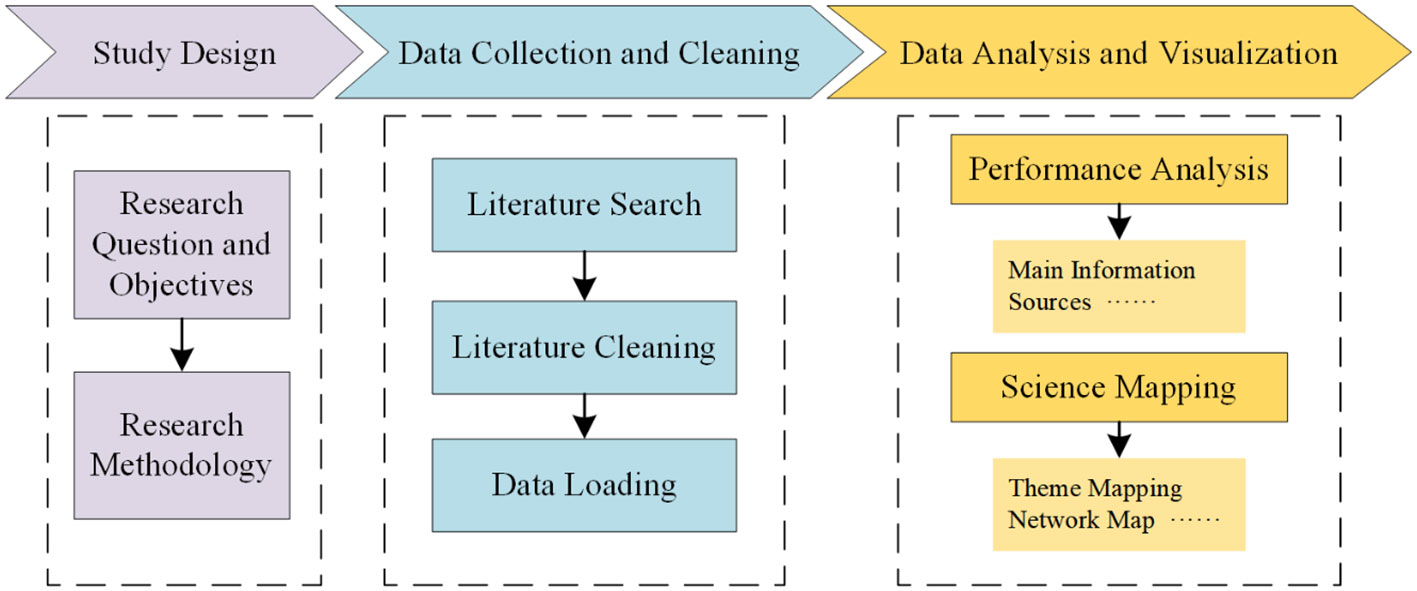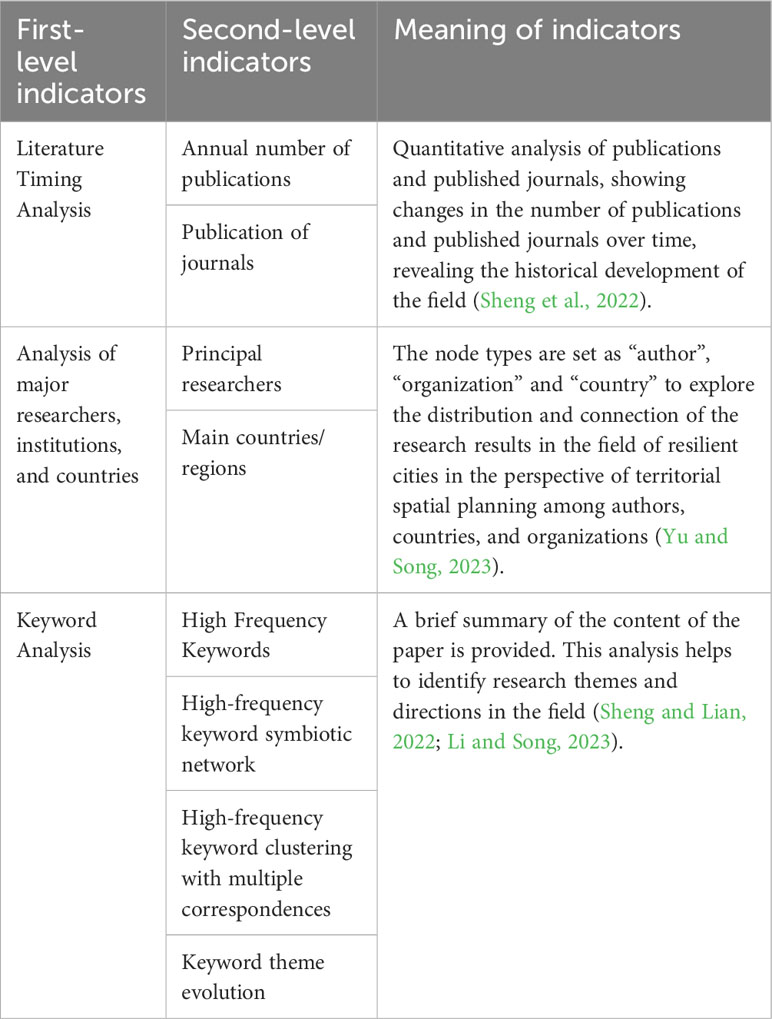- Henan Engineering Technology Research Center of Ecological Protection and Management of the Old Course of Yellow River, Shangqiu Normal University, Shangqiu, China
With the rapid progression of urbanization, cities are increasingly confronted with multifaceted challenges encompassing climate change, population expansion, and resource constraints. Consequently, fostering the development of resilient cities has emerged as a pivotal imperative within future territorial spatial planning. In this paper, we searched the Web of Science Core Collection database for data related to resilient cities in the perspective of territorial spatial planning from 2004 to 2022, and conducted a bibliometric analysis using the Bibliometrix R software package. The results show that: (1) From 2004 to 2022, the number of papers in the field of resilient cities research in the perspective of land spatial planning totaled 933, with a fluctuating upward trend of annual publications. The top three journals in terms of publication are Sustainability, Cities and Landscape and Urban Planning. (2) There are 2,651 researchers from 71 countries or regions contributing to the field,with the top three authors being SHARIFI A, BRUNETTA G, and BARTHEL S, but most of the authors (90.49%) have published only one paper. In addition, developed countries have strong research strength in this field. (3) The top ten keywords in the field of resilient cities research from the perspective of territorial spatial planning are Cities/City, Resilience, Management, Ecosystem services, Climate-change, Urban, Framework, Adaptation, Governance and Space. These keywords reflect the fact that topics related to resilience management and sustainable development of urban areas are hot topics in the field. Water, Health, Geography, Demand, Decision-Making and Built Environment are the research directions of resilient cities from the perspective of future territorial spatial planning.
1 Introduction
The city, as the most intricate social ecosystem, has been exposed to diverse external and internal shocks and disturbances since its inception (Shao and Xu, 2015; Chang et al., 2021). These disturbances include not only natural disasters such as earthquakes and floods, but also cumulative shocks caused by energy shortages, global climate change. (Jabareen, 2013; Zhang et al., 2023). With rapid urbanization, a growing world population and increasingly complex social networks, cities are being hit harder and harder (Liu et al., 2019; Yang et al., 2021). In the face of these shocks, there is a wide disparity in the response of different urban systems, and the essence of the different outcomes is the difference in urban resilience (Jennings et al., 2013; Pickett et al., 2014). Resilient cities are better able to adapt to uncertain perturbations, while less resilient cities lag in their ability to respond (Shao and Xu, 2015). Research on resilient cities has attracted extensive attention from academia and society, and there is now a wealth of theoretical and practical research. In 2015, the United Nations Sustainable Development Goals (UN-SDGs) took the enhancement of urban resilience as one of the global sustainable development goals. The construction of resilient cities has become an important issue in the process of global urbanization (Gao, 2019).
Toughness has its origins in physics and is used to describe the ability of an object to recover after deformation by an external force. By the 1970s, it was gradually introduced into ecology (Gunderson, 2000). Ecological resilience emphasizes the ability to adapt to external shocks and control interactive changes. As an important research component of ecology, the idea of resilience is naturally applied to urban research, laying the foundation for the formation of the theory of resilient cities (Auziņš, 2019; Liang, 2021). The concept of resilient cities has been widely accepted by countries around the world and has been incorporated into the fields of urban planning, urban construction, disaster prevention and mitigation and urban governance (Tao, 2022). At present, in order to cope with the latest challenges of globalization, urbanization and sustainable development, the conduct of territorial spatial planning will play a positive role in promoting national and regional economic and social development. Under the guidance of the idea of resilient cities, more and more attention has been paid to the study of the concrete practice of spatial planning, which involves urban design methods and principles, land use optimization strategies and landscape design strategies, and other aspects (Li et al., 2020). Resilient city research is facing a series of new requirements and challenges, and how to integrate resilient city research into the whole process of territorial spatial planning is one of the important issues to be solved.
Current research on resilient cities focuses on system characteristics, evaluation indicator systems and policy formulation. Studies have shown that urban resilience is related to spatial planning policy formulation in the context of climate uncertainty (Lu and Stead, 2013). Despite the importance of related research, there is still a lack of comprehensive overview studies on resilient cities. Resilient cities constitute a crucial interdisciplinary research domain encompassing ecological environment, engineering technology, economics, social sciences, and other disciplines. Within the framework of territorial spatial planning, enhancing resilience has emerged as a pivotal value orientation for spatial governance. Consequently, conducting bibliometric analysis becomes imperative to comprehensively comprehend the research progress and current focal points in the field of resilient cities.
Bibliometrics is a powerful tool for analyzing the progress of scientific research by quantifying the information in online scientific citation databases related to a specific research topic, including the distribution of research authors, number of publications, and research institutions in the field (Wang and Lu, 2020). In addition, the software could identify the important literature in the research field and quantifies the current status and future trends of the research topic (Rousseau, 2012). Bibliometrix is an open source tool developed in R for performing bibliometric analyses (Aria and Cuccurullo, 2017). It can import and convert literature data from databases such as Web of Science, and analyze and visualize literature information and results. A number of scholars have used this tool to quantitatively analyze the literature in ecology, geography, and other related fields (Xie et al., 2020; Li and Song, 2022).
Therefore, this paper will utilize a bibliometric approach by screening potential literature in the field of Territorial spatial planning and resilient cities research, followed by a comprehensive analysis and visualization of the literature published in the core database of Web of Science during the period of 2004-2022 using Bibliometrix software. In order to achieve the research objectives of this paper, the following questions are addressed: (1) What are the trends in the production of literature related to resilient cities in a territorial spatial planning perspective? (2) How have the journals, authors, research countries and institutions focusing on resilient cities in a territorial spatial planning perspective changed? (3) What are the research hotspots and themes in the field and how have they developed and evolved? (4) What are the future research directions in the field?
2 Research data and methods
2.1 Data
A comprehensive search of subject areas was conducted to collect literature on territorial spatial planning and resilient cities. After trial and error and consultation with experts, the following search formula was established: TS = (((spatial planning) or (space planning) or (territorial planning)) and ((resilient cities) or (resilient city) or (urban resilience))). To ensure the quality of the articles, restrictions are applied in the Web of Science Core Collection database. The language is full language, and document types are limited to Articles, Review Articles, and Conference Papers, excluding book chapters, editorial material, and other content. The search period ends at the end of 2022, and the initial year is the time when the relevant literature first appeared (2004). Finally, 954 data were filtered from 1719 data. Downloaded data is saved and exported in plain text format.
2.2 Methodology
Bibliometrics provides a more objective and reliable analysis of literature (Sheng et al., 2022). The literature review of this study can be divided into the following two steps. The first step includes the topic selection of the review, sorting and combining the different definitions of the keywords, searching in WoS, primary selection and detailed screening of the data, downloading and compressing the filtered data. It should be pointed out that “or” is used between different keys of the same definition; The preliminary screening time is limited to 2022, with the earliest studies as the initial time, and the search scope is “topic”; Detailed screening includes the type of literature and the category of journal. The second step is to use metrology software for literature metrology analysis, including data set import, data visualization analysis and mapping. Specific procedures and methods are as follows (Figure 1).
The research idea of this paper is shown in Figure 1. A comprehensive overview, analysis, and presentation of 954 data (screened in 2.1) was conducted by quantitatively analyzing the Web of Science Core Collection database to objectively identify past and present research topics and future research trends. The quantitative analysis of the bibliometrics was realized by means of the Bibliometrix R package. The Bibliometrix R package provides a set of tools for quantitative research. It is written in the R language and features efficient statistical analysis and visualization of large amounts of data. The indicators selected for the literature review are shown in Table 1.
3 Results
3.1 Analysis of the number of articles issued and the publishing journal
3.1.1 Annual trends in the number of publications
Over the timeframe spanning from 2004 to 2022, an extensive corpus of scholarly works, comprising 933 papers, has emerged within the domain of resilient cities from the vantage point of national spatial planning. These scholarly contributions reveal an overarching pattern characterized by undulating growth (refer to Figure 2). To discern the developmental phases within this chronology, we classify pertinent studies into three distinct epochs predicated upon publication frequency: 2004-2011, 2012-2019, and 2020-2022. The inaugural phase, extending from 2004 to 2011, denotes an embryonic stage marked by a dearth of scholarly output, with an annual average of fewer than ten papers. During this octennial span, these publications accounted for a mere 3.22% of the cumulative total. Subsequently, the period encompassing 2012 to 2019 signifies a juncture characterized by the expansion and dissemination of research. Notably, the annual publication rate surged significantly, registering an average of 52.4 papers per annum, constituting 44.91% of the aggregate publications. The most recent phase, commencing in 2020 and persisting to the present, represents an era of accelerated growth. Within this timeframe, research papers published account for an impressive 51.87% of the comprehensive body of works collated for this study. Evidently, during the brief interval from 2020 to 2022, the annual publication tally consistently surpassed 161.3 papers.
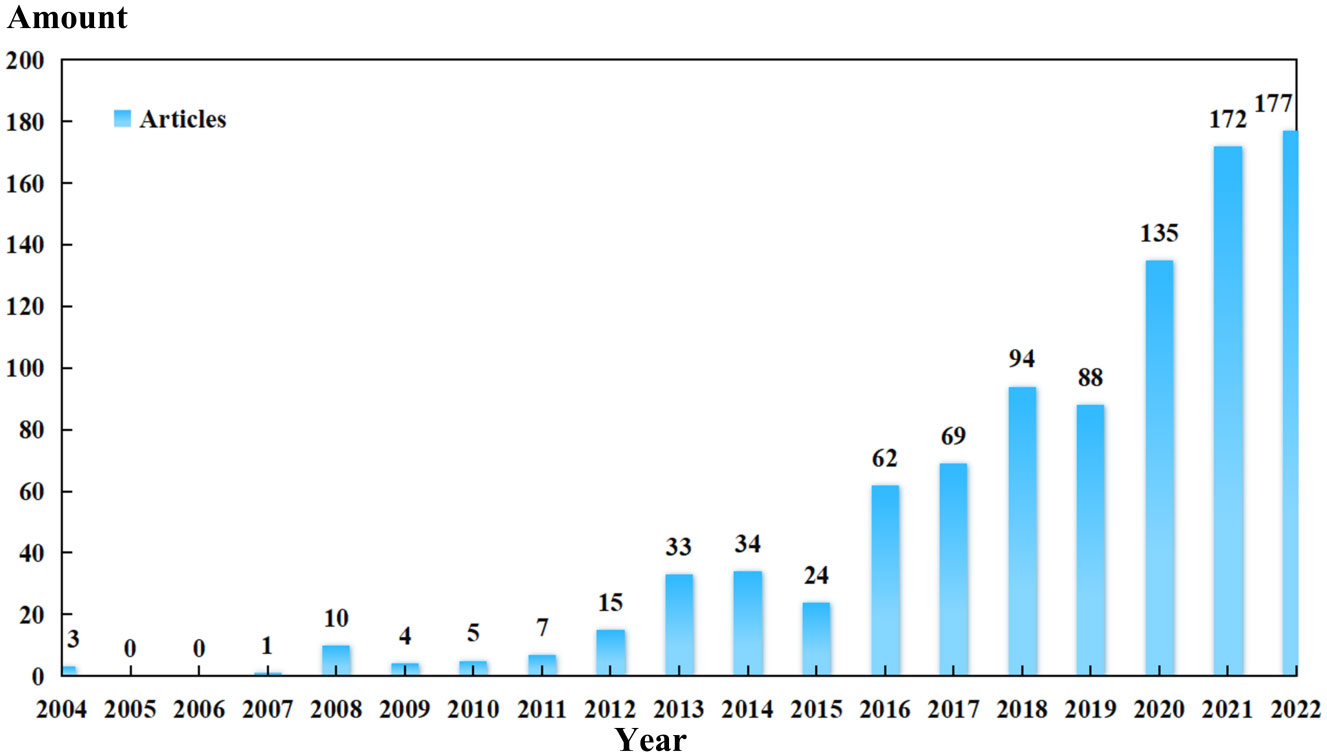
Figure 2 Analysis of the annual number of documents issued by resilient cities from the perspective of national spatial planning from 2004 to 2022.
3.1.2 Analysis of publication journals
From 2004 to 2022, the research landscape in the realm of resilient urban development, as approached from the purview of national spatial planning, has primarily gravitated toward two principal scholarly outlets: “Sustainability” and “Cities” (as depicted in the accompanying figure). Notably, “Sustainability” has ascended as the preeminent platform for academic discourse, boasting a publication record of 155 research papers. In a closely trailing position is the journal “Cities,” which has showcased 38 scholarly contributions, while “Landscape and Urban Planning” has accommodated 36 such works (as illustrated in Figure 3). It is noteworthy that both “Sustainability” and “Landscape and Urban Planning” exhibit a discernibly elevated H-index within this constellation of periodicals, emblematic of their substantial influence within this scholarly domain (as elucidated in Figure 4).
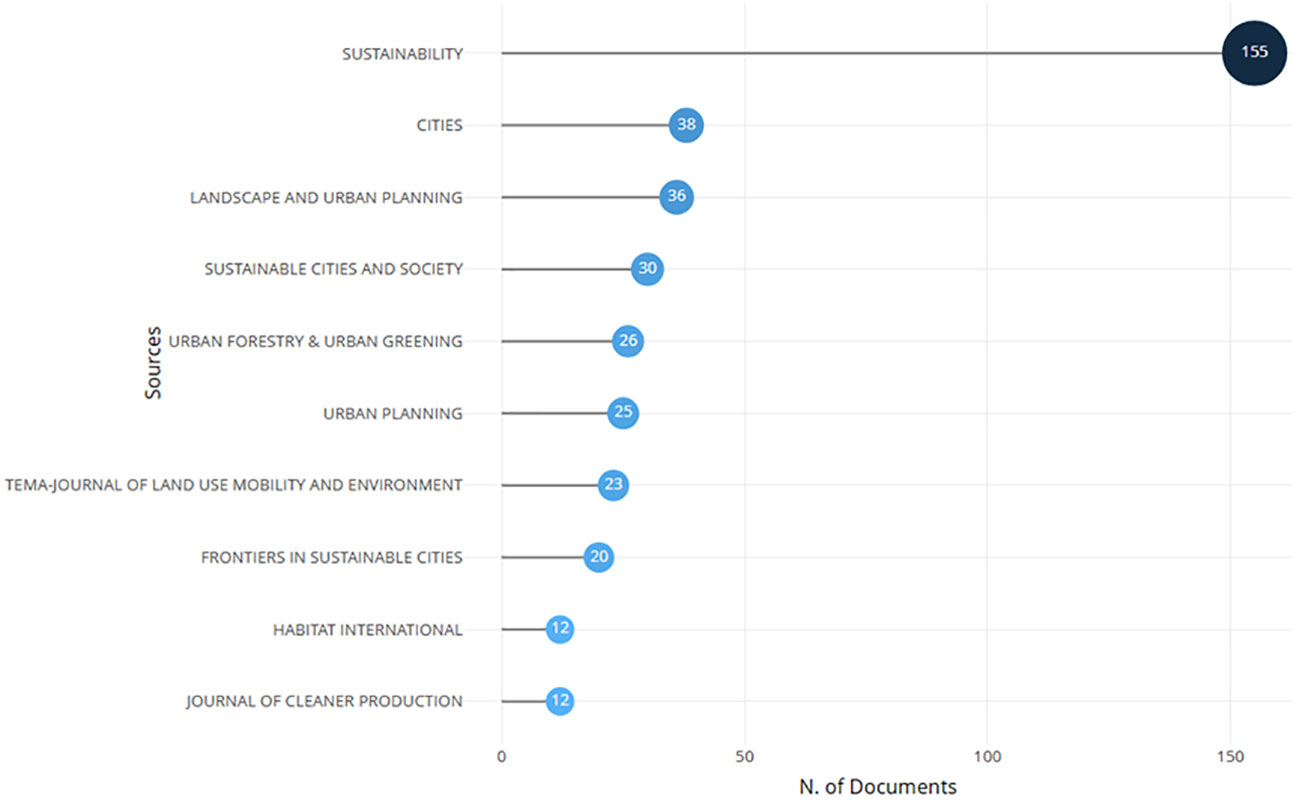
Figure 3 Top 10 periodicals in the field of resilient cities from the perspective of territorial spatial planning from 2004 to 2022.
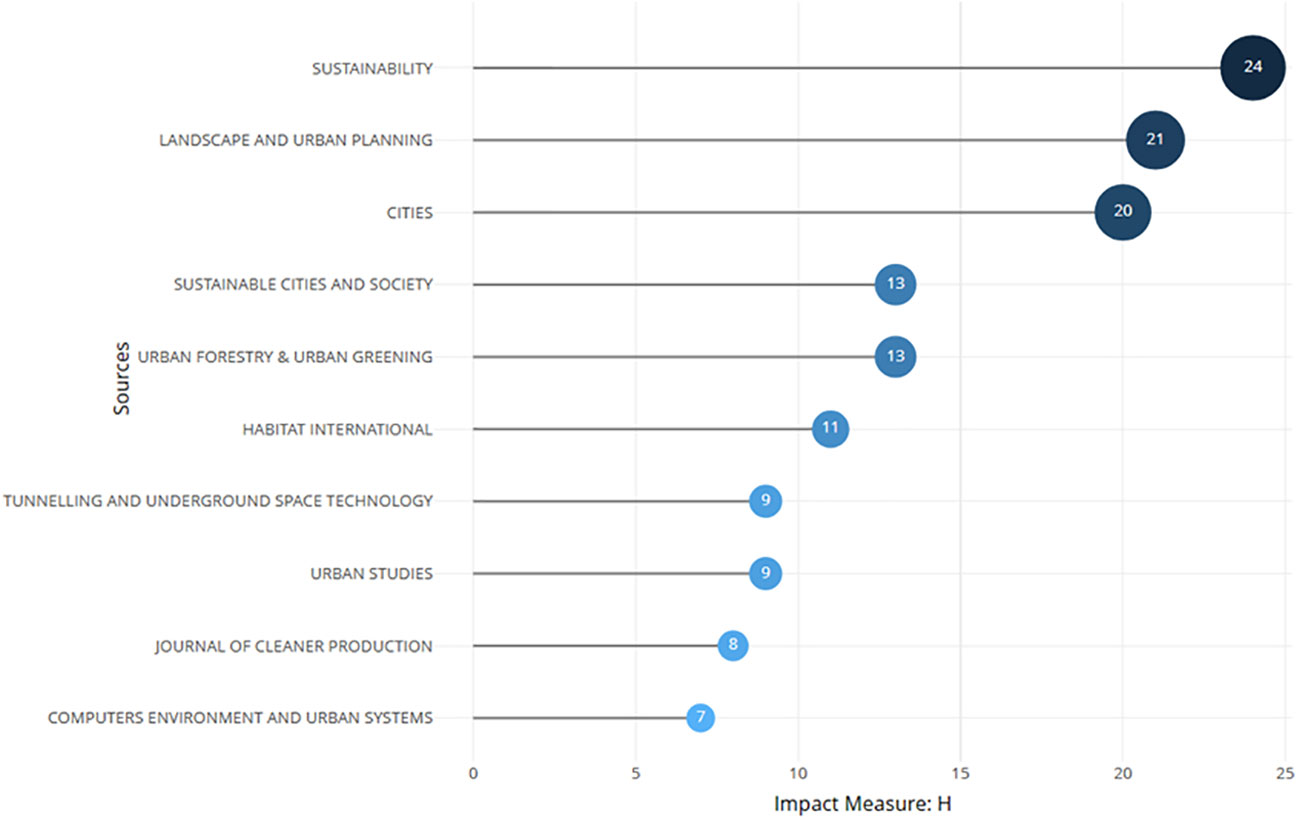
Figure 4 Top 10 journals in the H Index of resilient cities from the perspective of territorial spatial planning from 2004 to 2022.
The trend analysis concerning the top five journals, as determined by publication count (as depicted in Figure 5), yields noteworthy observations. Firstly, “Landscape and Urban Planning” has established a historical precedence, boasting a publication history that dates back to 2004. In contrast, “Sustainability,” although embarking on its scholarly journey at a later juncture, has displayed an impressive trajectory of exponential publication growth over time. Additionally, it is discernible that, spanning the period from 1990 to 2022, the remaining four journals have consistently and progressively expanded their publication output, underlining a persistent scholarly engagement within this field.
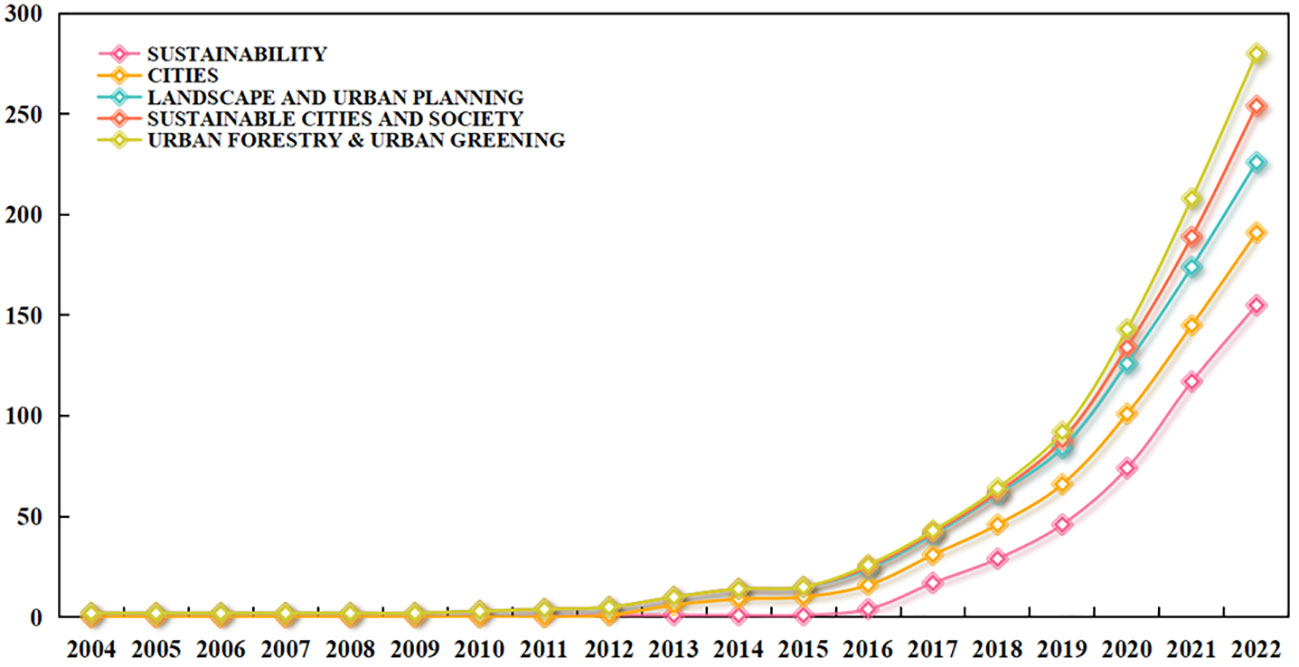
Figure 5 The publication trend of the top five journals in the field of resilient cities from the perspective of territorial spatial planning from 2004 to 2022.
3.2 Analysis of principal researchers, institutions, and nations
3.2.1 Principal researchers
The findings of this analysis reveal the involvement of a collective of 2,651 researchers in contributing to the research domain of resilient cities from the perspective of national spatial planning. Among this cohort, 65 authors have exhibited a notable commitment by authoring three or more papers within this field. Notably, the substantial proportion of authors, amounting to 90.49%, have contributed a solitary paper, signifying a prevailing pattern of relatively limited sustained engagement among experts in this particular domain.
In accordance with the evaluative criteria pertaining to the contributions and scholarly impact of researchers within this purview, the following enumeration delineates the foremost ten influential scholars: ANGUELOVSKI I, BARTHEL S, BRUNETTA G, SALVATI L, SHARIFI A, ADMIRAAL H, ANDERSSON E, CAI M, CONNOLLY JJT, and HAASE D (as tabulated in Table 2). Among this cohort, ANGUELOVSKI I, who embarked on research endeavors in this domain in 2016, has proffered five published works, accrued a cumulative citation count of 512, and lays claim to the highest h-index while ranking within the top three for g-index. These metrics underscore ANGUELOVSKI I’s preeminent stature within the sphere of national spatial planning and resilient cities. Meanwhile, BRUNETTA G, commencing scholarly inquiries in this field in 2013, excels in terms of prolificacy with seven publications, shares the pinnacle h-index, and clinches the highest g-index; however, it is noteworthy that the total citation count remains comparatively modest, amounting to 84.
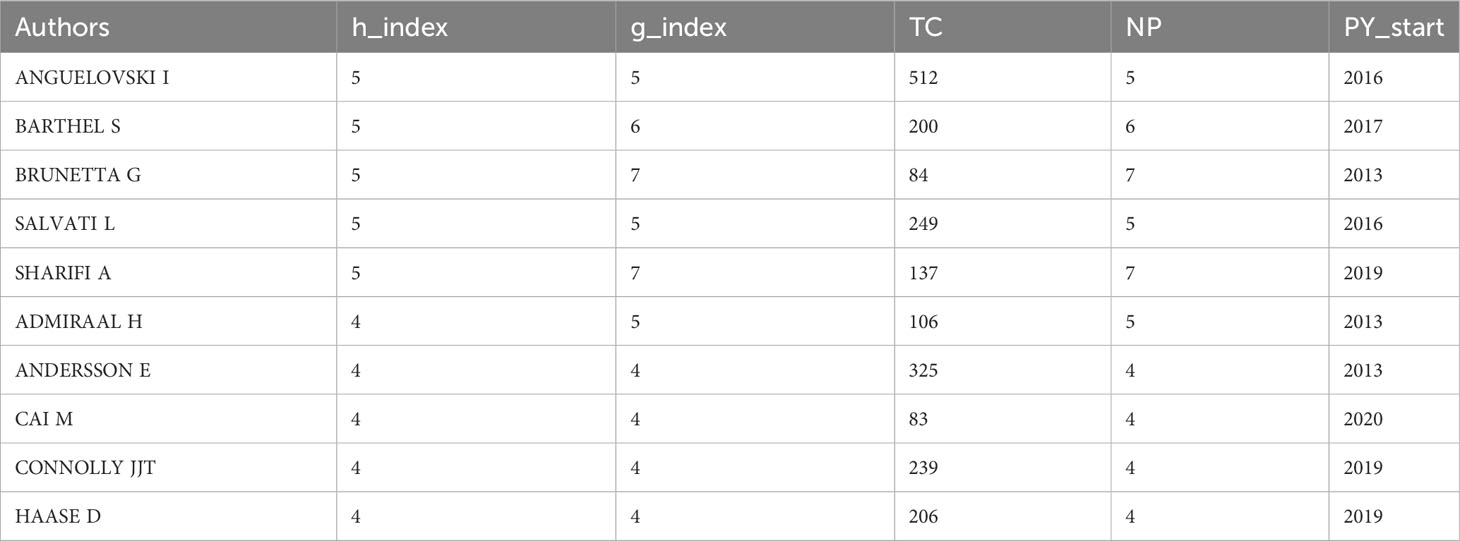
Table 2 Top 10 most influential scholars in the field of resilient cities from the perspective of national spatial planning from 2004 to 2022.
A more comprehensive analysis of the results unveils that ANGUELOVSKI I’s most prominently cited contributions within this domain materialized in the year 2016, garnering an average citation frequency of 34.12 occurrences (as delineated in Figure 6). Furthermore, BRUNETTA G exhibited a peak in publication output during the year 2019, amassing five papers, with an associated average citation frequency of 15.4 instances.
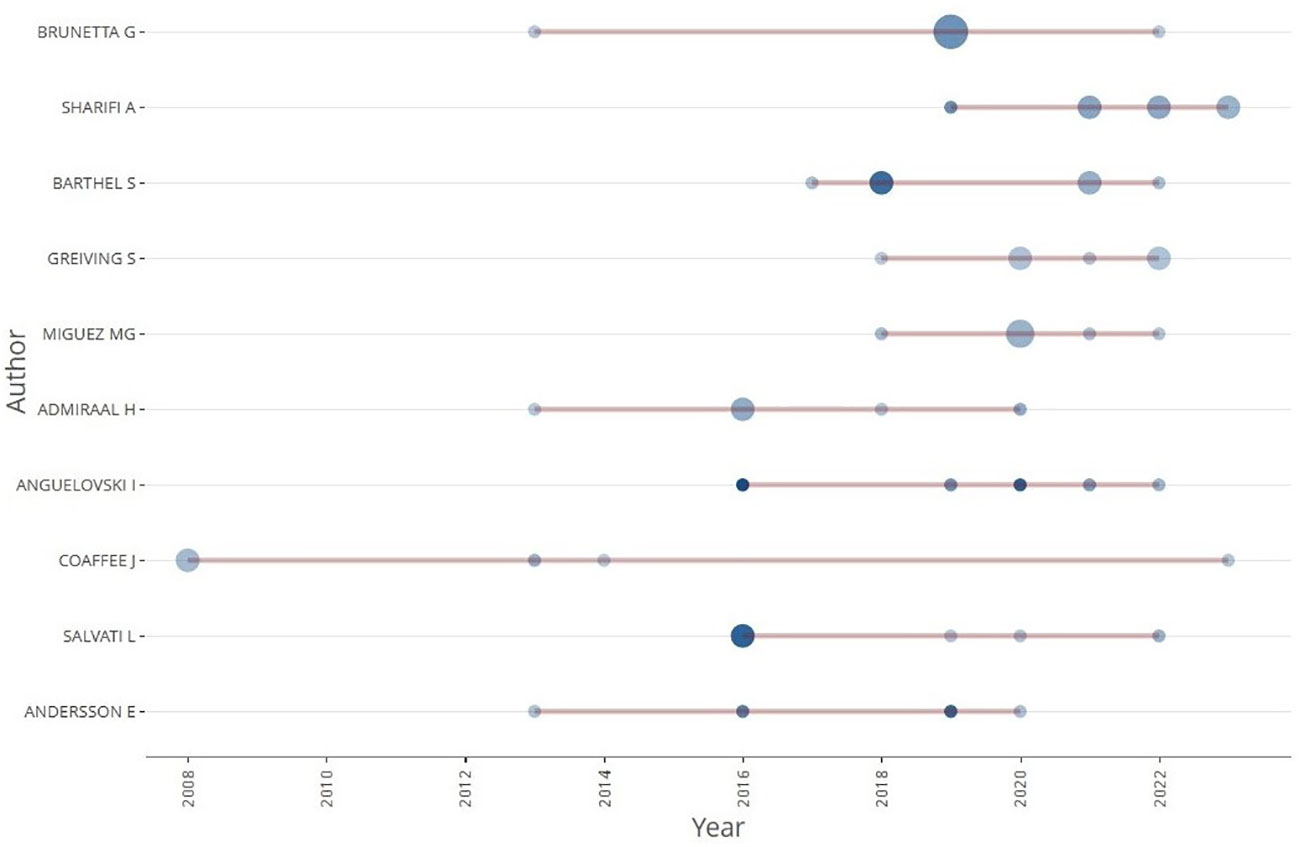
Figure 6 Changes of article output in the field of resilient cities over time from the perspective of national spatial planning from 2004 to 2022. The size of the circle indicates the number of documents, and the shade of the color indicates the number of citations.
3.2.2 Leading nations
The publication of research papers by different countries provides valuable insights into their prominence and influence within the realm of resilient cities from the perspective of national spatial planning. Since 2004, a total of 71 countries or regions have actively contributed to research in this field. Among the top ten nations with the highest publication volumes (as detailed in Table 3), a diverse representation emerges, encompassing two Asian nations (China and Israel), one from the Americas (the United States), six European countries (Italy, the United Kingdom, the Netherlands, Spain, Sweden, and Germany), and one from Oceania (Australia). The United States claims the highest number of published papers, tallying at 271, and maintains a commendable average citation frequency ranking third at 37.70. This noteworthy metric underscores the notably high quality of papers emanating from the United States. Conversely, Canada, with the lowest publication count at 51, distinguishes itself by commanding the highest average citation frequency at 71, attesting to the superior quality of Canadian contributions within this field. Following closely in terms of average citation frequency are Sweden (41.10) and the Netherlands (22.20). This revelation serves as a testament to the robust research capabilities inherent in developed nations operating within this domain.
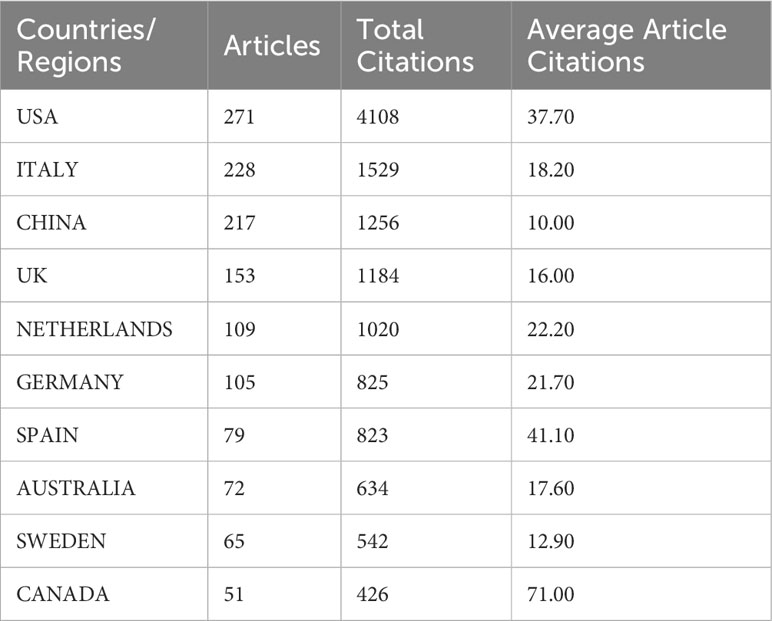
Table 3 The top 10 countries in terms of papers published on resilient cities from the perspective of territorial spatial planning between 2004 and 2022.
An examination of international collaborative research outcomes on a global scale (as presented in Figure 7) elucidates distinct levels of collaboration among nations, leading to the delineation of two discernible clusters. In the domain of national spatial planning and resilient cities, a notable deepening of collaboration and knowledge exchange has been observed among scholars from Italy, the United Kingdom, and the Netherlands. In contrast, the United States, China, and Australia manifest closer interconnections within this field. Furthermore, the network analysis underscores the United States’ preeminence in the number of international collaborations, with Italy and China following closely. While the United States surpasses both Italy and China in terms of the sheer quantity of published papers, China’s robust international linkages suggest a higher degree of autonomy in research endeavors among Chinese scientists. This phenomenon underscores the evolving dynamics of global scholarly engagement in this domain.
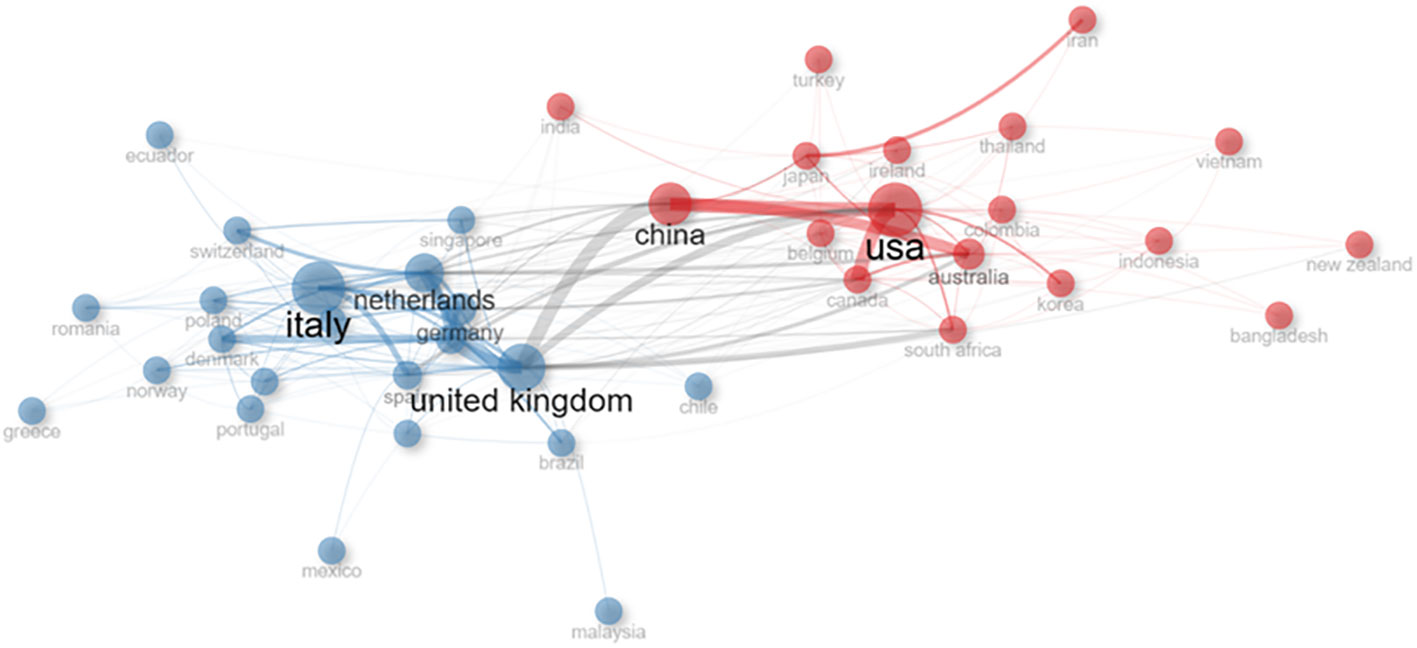
Figure 7 National cooperation networks in the field of resilient cities from the perspective of national spatial planning from 2004 to 2022. Note: The 40 circles generated represent cooperation maps for 40 countries. The same color means that these countries are in the same cooperative network. The size of the circle indicates the amount of research produced. The connecting lines between countries indicate the status of cooperation between these countries, and the thickness of the lines indicates the intensity of cooperation.
3.3 Keyword analysis
3.3.1 Analysis of high-frequency keywords
Within the realm of national spatial planning and resilient cities, the examination of the top 100 high-frequency keywords offers valuable insights into prevailing research focal points (as visually represented in Figure 8). The preeminent ten keywords and their corresponding frequencies are elucidated as follows: “Cities/City” (242 occurrences), “Resilience” (158 occurrences), “Management” (81 occurrences), “Ecosystem Services” (72 occurrences), “Climate Change” (71 occurrences), “Urban” (63 occurrences), “Framework” (61 occurrences), “Adaptation” (58 occurrences), “Governance” (46 occurrences), and “Space” (46 occurrences). These keywords effectively encapsulate the central thematic contours and areas of paramount significance within this field of inquiry. Of noteworthy significance is the distinctive attention bestowed by scholars upon topics inextricably linked to resilient urban administration and the sustainable development of urban environs. These encompass the augmentation of ecosystem services within urban settings, the fortification of governmental capacities, and strategies for effectively contending with the impending challenges emanating from evolving climate patterns.
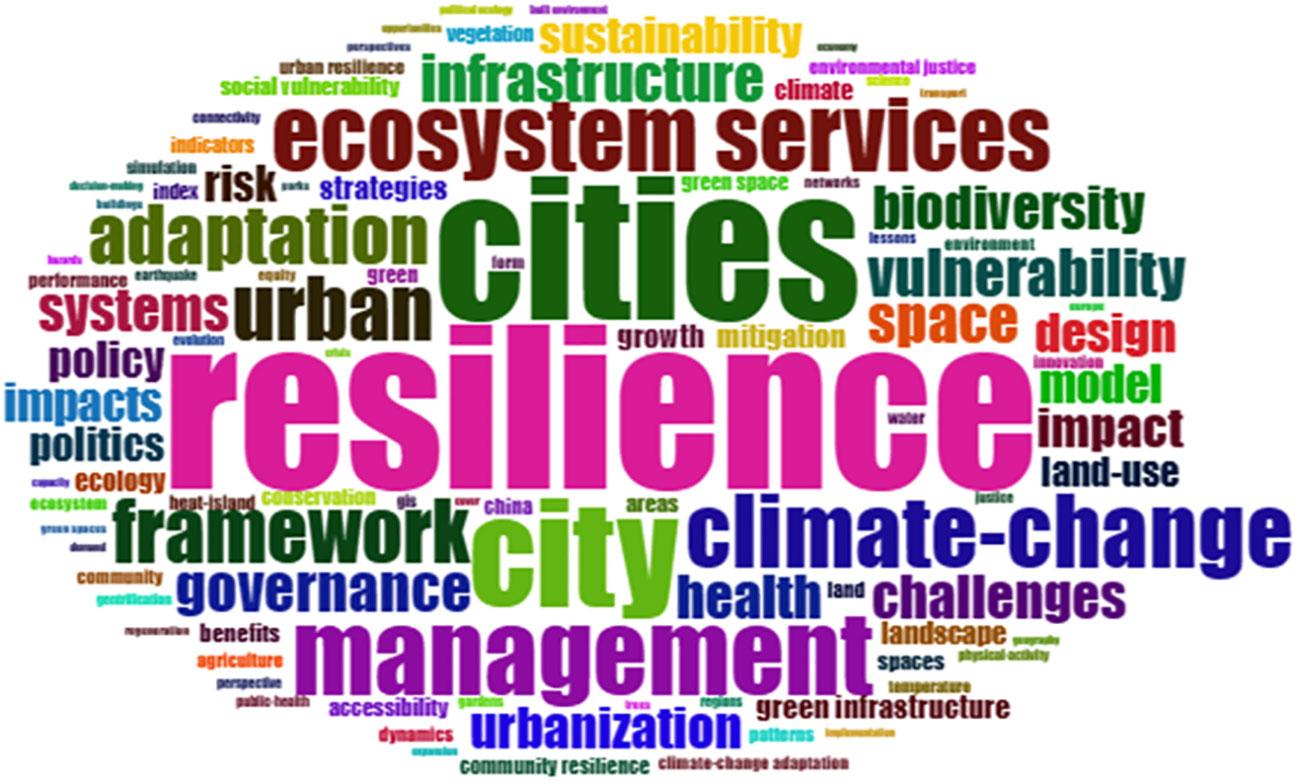
Figure 8 Cloud map of high frequency keywords in the field of resilient city research from the perspective of national spatial planning from 2004 to 2022.
3.3.2 Analysis of high-frequency keyword co-occurrence network
A meticulous clustering analysis of keywords within the domain of national spatial planning and resilient cities has been undertaken, leading to the formulation of a network illustrating the co-occurrence of keywords (as visually represented in Figure 9). This resultant co-occurrence network delineates four distinct clusters, each anchored by core nodes: “Management,” “City,” “Cities,” and “Resilience.” Furthermore, the robust interconnectivity observed among these four nodes underscores the critical importance of scientifically grounded planning and management policies in the effective realization of resilient cities within the framework of national spatial planning.
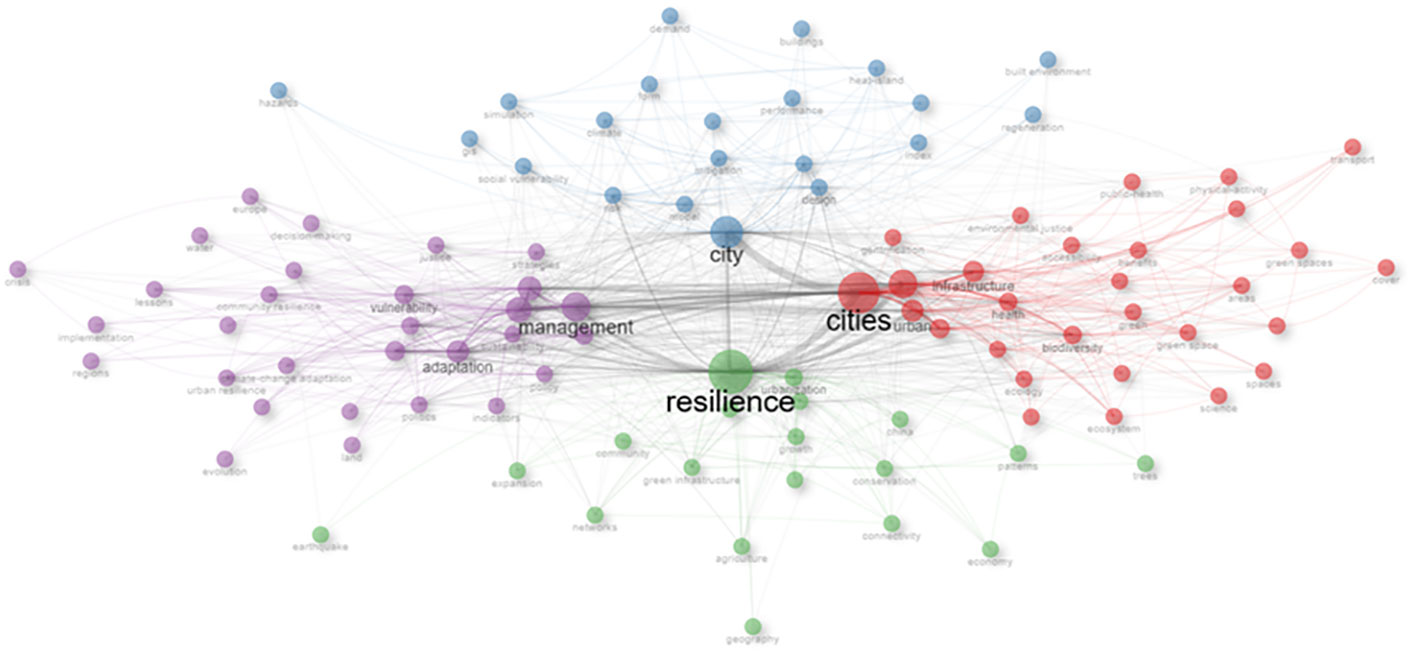
Figure 9 Network analysis of the top 100 keywords in the field of resilient city from the perspective of national spatial planning from 2004 to 2022.
3.3.3 Cluster analysis and multiple correspondence analysis of high-frequency keywords
Cluster analysis of high-frequency keywords offers an intuitive means of delineating research directions and thematic foci within a specific research domain. This analytical approach groups keywords based on their interrelationships, thus shedding light on the extent of associations within the field. Through the lens of high-frequency keyword cluster analysis (as presented in Figure 10), the realm of national spatial planning and resilient cities can be effectively categorized into four primary research directions. The first direction pertains to theoretical inquiries into resilient cities from the vantage point of national spatial planning, with a pronounced emphasis on the field’s evolution and underlying mechanisms. The second direction delves into spatial planning strategies aimed at bolstering urban resilience, particularly addressing vulnerabilities within urban communities and grassroots organizations. The third direction scrutinizes the intricate feedback mechanisms and ramifications of spatial planning within resilient cities, particularly in the context of confronting challenges such as climate change. Finally, the fourth direction accentuates the imperative alignment of spatial planning endeavors with the principles of resilient cities within the purview of social sustainability. This encompasses a wide spectrum of considerations encompassing land systems, ecosystems, social systems, policy mechanisms, and the practical implementation of research findings within spatial planning and design frameworks.
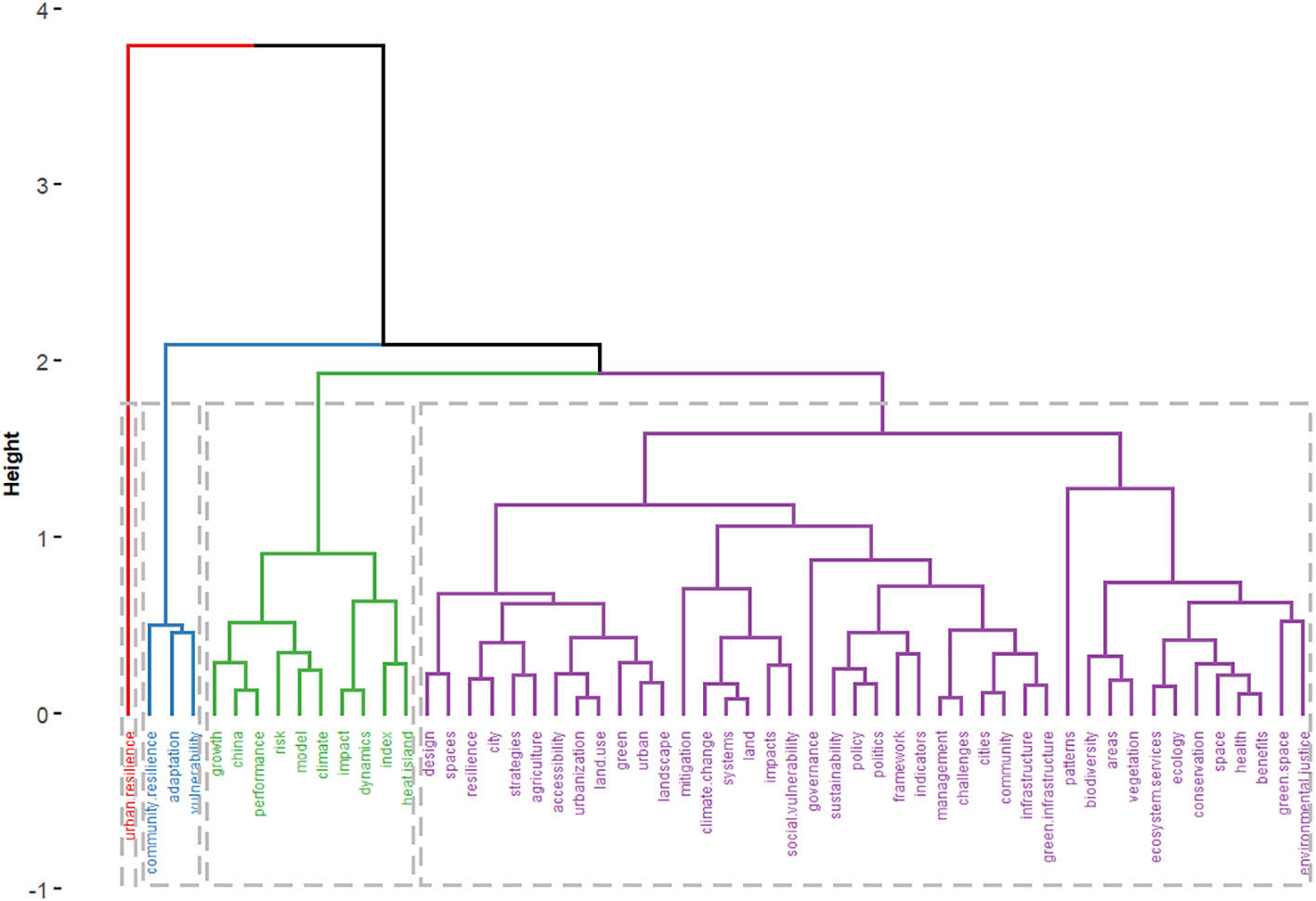
Figure 10 Hierarchical clustering analysis of high frequency keywords in the field of territorial spatial planning and resilient city from 2004 to 2022. Different colors in the figure represent different clusters.
3.3.4 Analysis of theme evolution
The topic of territorial spatial planning and resilient cities is visually presented, and it is found that the related research topics in this field are divided into three stages in Figure 11. The initial phase (2004-2011) denotes a period characterized by the developmental emergence of research in the context of national spatial planning and resilient cities. During this epoch, the predominant themes revolved primarily around “City,” “Biodiversity,” and “Conservation.” The subsequent phase (2012-2020) marked a phase of thematic enrichment, with a pronounced emphasis on “Resilience,” “Impact,” “Framework,” and “Space Syntax.” This phase demonstrated a discernible trend toward comprehensive development from a multifaceted perspective.
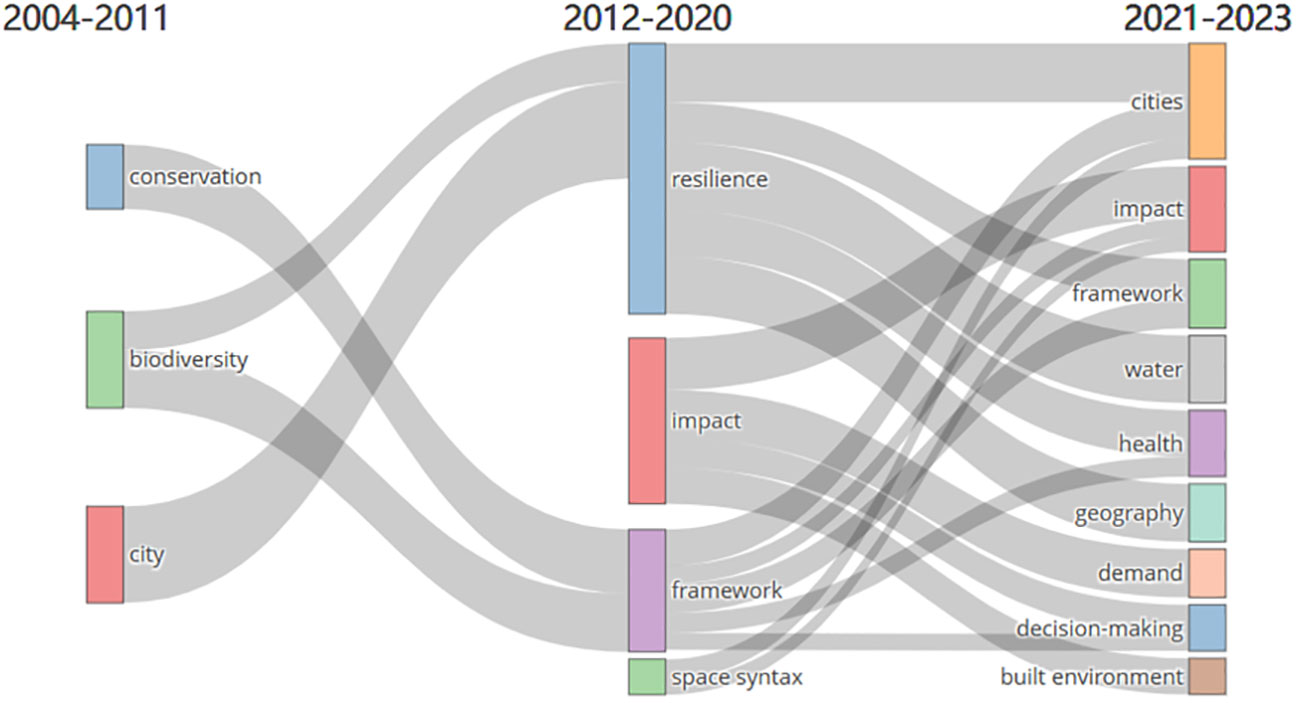
Figure 11 Thematic evolution in the field of territorial spatial planning and resilient cities from 2004 to 2022.
The concluding phase (2021-2022) signifies a pronounced shift toward diversified and multifaceted research themes. Central themes in this period encompass “Cities,” “Impact,” “Framework,” “Water,” “Health,” “Geography,” “Demand,” “Decision-making,” and “Built Environment.” This transformation underscores an enhanced emphasis on human sustainable development and environmentally-friendly practices within the purview of national spatial planning and resilient cities research.
4 Discussion
4.1 Analysis of resilient cities trends in the context of national spatial planning
The development of resilient cities is intrinsically linked to comprehensive urban planning and management (Leitner et al., 2018). Within the domain of national spatial planning, it becomes imperative to carefully deliberate over factors encompassing sustainable urban development, ecological conservation, and socioeconomic prosperity. To illustrate, within the realm of national spatial planning, it is imperative to harmonize the urban development agenda with the imperatives of nature conservation, ensuring the preservation and rejuvenation of urban ecosystems. In tandem, prudent urban infrastructure planning is essential to heighten urban resilience and bolster emergency responsiveness (Pontrandolfi, 2020).
Resilient cities place notable emphasis on community participation and collaboration (Wang et al., 2018). The active engagement of community residents affords invaluable experiential insights and knowledge, thereby fostering democratization and transparency in the ambit of urban planning. Furthermore, robust collaboration among diverse municipal departments and stakeholder groups constitutes a pivotal constituent of resilient city-building. It is only through such concerted synergies that cities can efficaciously confront an array of challenges and dynamic transformations.
In addition, resilient cities are compelled to accentuate the application of technological innovation (Evans and Karecha, 2014). Cutting-edge technologies, such as smart transportation systems and intelligent energy management, have the potential to augment urban efficiency and sustainability. By way of example, smart transportation systems hold promise in ameliorating traffic congestion and emissions, thereby elevating the efficiency and safety of urban transportation networks. Similarly, intelligent energy management initiatives can judiciously optimize energy utilization, curtail energy wastage, and curbing reliance on conventional energy sources.
4.2 Analysis of resilient city practices from the perspective of national spatial planning
Within the framework of national spatial planning, the implementation of resilient city practices plays a pivotal role in ensuring both sustainable urban development and the safety and well-being of urban populations. First and foremost, national spatial planning assumes a central role in ensuring the rational allocation of urban space and the coherent distribution of urban functions. Through the application of rigorous planning methodologies, urban scale, functional zoning, and infrastructure deployment can be judiciously orchestrated, thereby enhancing urban operational efficiency and resilience (Leitner et al., 2018). Secondly, national spatial planning takes into meticulous consideration the natural environment and ecosystems within urban landscapes, thereby fostering ecological preservation, risk mitigation against natural calamities, and augmenting urban adaptability (Pontrandolfi, 2020). Furthermore, it contributes to the promotion of coordinated development among urban centers, resulting in resource efficiency and a diminished environmental footprint.
From the perspective of national spatial planning, the practical implementation of resilient cities warrants profound reflection on the seamless integration of urban planning with the principles of sustainability. The resilient city concept underscores urban adaptability and resilience when confronted with diverse challenges, such as natural disasters, climate change, and socioeconomic fluctuations. To attain this goal, planners must embrace a multi-tiered planning approach, harmonizing national, urban, and community-level planning to ensure holistic urban resilience. Land use and spatial layout should be optimized, thereby avoiding construction within high-risk zones and simultaneously creating accessible green spaces that facilitate evacuation and post-disaster recovery. Additionally, the establishment of green infrastructure proves to be instrumental, as it bolsters environmental sustainability through urban parks, water management systems, and enhanced vegetation coverage, ultimately mitigating the impacts of climate change (Lee et al., 2021). Considering these factors comprehensively, the practical implementation of resilient cities from the vantage point of national spatial planning can offer robust support for the long-term sustainable development and disaster resilience of urban environments.
In the practice of resilient cities, it becomes imperative that national spatial planning incorporate the objectives of resilient cities into planning policies. Firstly, the planning process should prioritize the multifaceted and intricate nature of urban centers. Urban planning endeavors should take into full account the interplay and convergence of various functional zones, thereby mitigating the development of single-purpose areas and fortifying urban resilience and adaptability. Secondly, national spatial planning should accentuate urban compactness and intensification. By judiciously demarcating urban development boundaries, the encroachment of land can be minimized, land use efficiency heightened, and urban sustainability achieved (Sheng et al., 2022). Furthermore, national spatial planning should underscore urban accessibility and the meticulous planning of transportation networks. An efficient transportation system serves to enhance urban resilience and adaptability, curbing traffic congestion and energy consumption (Goncalves and Ribeiro, 2020). To fulfill the aims of resilient cities, national spatial planning necessitates the close collaboration of pertinent stakeholders and experts. The active engagement of government entities, private enterprises, local communities, and the public-at-large stands as paramount in the realization of resilient cities (Schauppenlehner-Kloyber and Penker, 2016). National spatial planning should actively encourage public involvement and input, thoroughly addressing their needs and expectations, thereby ensuring the viability and sustainability of urban planning endeavors.
4.3 Future research directions for resilient cities from the perspective of national spatial planning
Examining the trajectories for the development of resilient cities through the lens of national spatial planning is integral to ensuring urban locales remain steadfast and sustainable when confronted with forthcoming challenges. These research domains encompass climate change adaptation, urban infrastructure resilience, community engagement, digital urban planning, resource sustainability, urban policies and governance, urban innovation and technological applications, and social equity and inclusivity resilience. A comprehensive exploration of these facets can furnish a structured framework for crafting urban strategies, fortifying urban resilience, and safeguarding the quality of life and environmental sustainability of urban inhabitants. These research directions are inextricably tied not only to the future of urban environments but also harmoniously aligned with the overarching objectives of global sustainable development.
4.3.1 Climate change adaptation and mitigation
Climate change stands as an imposing global challenge bearing profound implications for urban landscapes. Future endeavors in the realm of national spatial planning must delve rigorously into the intricacies of provisioning urban areas for climate change adaptation. This remit encompasses the imperative to mitigate flood risks, enhance resistance to urban heat island effects, secure water resources, and address rising sea levels (Wang, 2022). Proactive measures include the enhancement of drainage systems, augmentation of green cover, and augmentation of building energy efficiency to mitigate the impacts of climate change. Additionally, cities should formulate comprehensive climate action plans, bolstering emergency response capacities and ensuring the safety of urban residents during extreme climate events.
4.3.2 Resilience of urban infrastructure
Urban infrastructure systems are the linchpin of urban functionality (Sheng et al., 2023), yet their vulnerability to natural disasters and emergencies is conspicuous. Accordingly, prospective national spatial planning should place a premium on bolstering the resilience of urban infrastructure. This encompasses a purview extending over water supply, electricity, transportation, communication, and waste management systems (Shaker et al., 2019). In this context, research should be directed toward the design and modernization of these systems, enhancing their capacity to withstand disasters and emergencies. Notably, cities can invest judiciously in the construction of sustainable and resilient water supply systems, ensuring the provisioning of a reliable water source for residents even in times of drought or emergencies.
4.3.3 Community engagement and social resilience
The active engagement of communities constitutes a linchpin in the construction of resilient cities. Within the rubric of prospective national spatial planning, scrutiny should be directed toward the augmentation of urban resilience through the prism of community participation and the cultivation of social capital (Wang et al., 2018). This necessitates the cultivation of an environment that encourages residents to actively engage in urban planning and disaster preparedness and nurtures the bonds of social cohesion. Such community engagement augments urban adaptability, granting residents greater autonomy in urban decision-making and emergency response actions, ultimately redounding to the resolution of urban challenges while concurrently bolstering social unity and cohesion.
4.3.4 Digital urban planning
The meteoric ascendancy of digital technology engenders newfangled tools and methodologies for urban planning. In the context of future national spatial planning, the confluence of data science and advanced urban models can substantially enhance urban planning processes, engendering superior predictive capabilities and management acumen to navigate urban risks, be they natural disasters, traffic congestion, or resource management concerns (Ye et al., 2023). For instance, cities are poised to harness the analytical potential of big data to pinpoint latent risk zones and to proffer bespoke planning interventions. Furthermore, digital technology augments operational efficiencies and resource utilization within urban environments.
4.3.5 Resource sustainability and environmental resilience
The sustainable evolution of urban ecosystems is inexorably tethered to the sustainable exploitation of resources (Wu et al., 2022). Future national spatial planning ought to scrutinize how to advocate for resource sustainability, encompassing domains such as energy, water resources, and land usage (Xu et al., 2020). The gambit includes the vouchsafement of renewable energy, waste management, and the development of green infrastructure (Kabisch, 2019). Cities can promulgate policies that incentivize energy conservation and the incorporation of renewable energy sources, thereby mitigating dependencies on finite resources (Li et al., 2023).
4.3.6 Urban policies and governance
Urban policies and governance serve as the bedrock upon which resilient cities are founded. In the context of prospective national spatial planning, analysis should be devoted to the methodologies of buttressing urban resilience through the prism of policies and governance measures. This ambit spans the gamut of regulations, urban planning paradigms, and emergency management policies. Notably, the establishment of cross-sectoral collaboration frameworks equips cities to amplify the integration of urban planning and management, thereby bolstering urban aptitude to grapple with multifaceted challenges (Sanchez et al., 2018).
4.3.7 Urban innovation and technological applications
Emergent technologies such as the Internet of Things, artificial intelligence, and big data portend the amplification of urban resilience (Arfanuzzaman, 2021). In future national spatial planning, connoisseurship should be applied to the harnessing of these technologies to augment urban operational efficiency, monitor disaster contingencies, and elevate infrastructure. To wit, cities have the capacity to institute intelligent traffic systems for the augmentation of traffic flow and the attenuation of traffic accidents (Gao and Li, 2022). Furthermore, data analytics proffers the capability to monitor environmental dynamics and enhance air and water quality.
4.3.8 Social equity and inclusive resilience
Urban resilience should be built in such a way as to ensure that it does not exacerbate social inequalities. Future territorial spatial planning needs to focus on how to take into account the needs of vulnerable groups in resilient urban planning to ensure that all residents can benefit from resilience measures (Schauppenlehner-Kloyber and Penker, 2016). This includes the provision of appropriate social benefits, secure employment opportunities and educational resources.
5 Conclusion
Using bibliometric analysis, this paper relies on the Web of Science Core Collection database to explore the future directions, challenges, and opportunities of researching resilient cities in the context of territorial spatial planning from the perspective of literature chronological analysis, main researchers and high-frequency keywords. Overall, from 2004 to 2022, the number of annual publications has continued to increase based on relevant research on resilient cities in the perspective of territorial spatial planning. Globally, 71 countries/regions have contributed to this field. China has the most prominent research results in developing countries, and the United States has the greatest influence in the field among developed countries. In addition, in terms of national cooperation, the United States, China and Australia are the most closely linked in this field.
It is crucial to study resilient cities in future territorial spatial planning, which involves a number of areas, including climate change adaptation, infrastructure resilience, community participation, digital urban planning, resource sustainability, policy governance, science and technology applications and social equity. In addition, building resilient cities requires cross-sectoral cooperation and the participation of the whole society in order to meet the challenges of future urban development and ensure the sustainable development of cities and the well-being of their residents.
Author contributions
GY: Conceptualization, Data curation, Funding acquisition, Methodology, Software, Writing – original draft, Writing – review & editing. PZ: Data curation, Methodology, Software, Writing – original draft. FY: Conceptualization, Data curation, Funding acquisition, Methodology, Software, Writing – original draft, Writing – review & editing. XZ: Conceptualization, Data curation, Funding acquisition, Methodology, Software, Writing – original draft, Writing – review & editing.
Funding
The author(s) declare financial support was received for the research, authorship, and/or publication of this article. This research was supported by Key Scientific Research Project of Colleges and Universities in Henan Province, study on the planning path of the old Yellow River pastoral complex in East Henan Province under the background of rural revitalization (Grant No. 23B560008), program for Science & Technology Innovation Talents in Universities of Henan Province (Grant No. 21HASTIT015) and the Key Scientific Research Project of Colleges and Universities in Henan Province (Grant No. 232102320347).
Conflict of interest
The authors declare that the research was conducted in the absence of any commercial or financial relationships that could be construed as a potential conflict of interest.
Publisher’s note
All claims expressed in this article are solely those of the authors and do not necessarily represent those of their affiliated organizations, or those of the publisher, the editors and the reviewers. Any product that may be evaluated in this article, or claim that may be made by its manufacturer, is not guaranteed or endorsed by the publisher.
References
Arfanuzzaman M. (2021). Harnessing artificial intelligence and big data for SDGs and prosperous urban future in South Asia. Environ. Sustainability Indic. 11, 100127. doi: 10.1016/j.indic.2021.100127
Aria M., Cuccurullo C. (2017). bibliometrix: An R-tool for comprehensive science mapping analysis. J. informetrics 11 (4), 959–975. doi: 10.1016/j.joi.2017.08.007
Auziņš A. (2019). Capitalising on the European research outcome for improved spatial planning practices and territorial governance. Land 8 (11), 163. doi: 10.3390/land8110163
Chang H., Pallathadka A., Sauer J., Grimm N. B., Zimmerman R., Cheng C., et al. (2021). Assessment of urban flood vulnerability using the social-ecological-technological systems framework in six US cities. Sustain. Cities Soc. 68, 102786. doi: 10.1016/j.scs.2021.102786
Evans R., Karecha J. (2014). Staying on top: why is munich so resilient and successful? Eur. Plann. Stud. 22 (6), 1259–1279. doi: 10.1080/09654313.2013.778958
Gao D., Li S. (2022). Spatiotemporal impact of railway network in the Qinghai-Tibet Plateau on accessibility and economic linkages during 1984–2030. J. Transport Geogr. 100, 103332. doi: 10.1016/j.jtrangeo.2022.103332
Gao W. (2019). A study on the idea of resilient city and its application in planning and practice in China. IOP Conf. Series: Earth Environ. Sci. 233 (5), 52046. doi: 10.1088/1755-1315/233/5/052046
Goncalves L., Ribeiro P. J. G. (2020). Resilience of urban transportation systems. Concept, characteristics, and methods. J. Transport Geogr. 85, 102727. doi: 10.1016/j.jtrangeo.2020.102727
Gunderson L. H. (2000). Ecological resilience—In theory and application. Annu. Rev. Ecol. Systematics 31 (1), 425–439. doi: 10.1146/annurev.ecolsys.31.1.425
Jabareen Y. (2013). Planning the resilient city: Concepts and strategies for coping with climate change and environmental risk. Cities 31, 220–229. doi: 10.1016/j.cities.2012.05.004
Jennings B. J., Vugrin E. D., Belasich D. K. (2013). Resilience certification for commercial buildings: a study of stakeholder perspectives. Environ. Syst. Decisions 33 (2), 184–194. doi: 10.1007/s10669-013-9440-y
Kabisch S. (2019). Urban transformations to pursue sustainability through resource efficiency, quality of life and resilience: a conceptual approach. Geographia Technica 14, 98–107. doi: 10.21163/gt_2019.141.23
Lee H., Song K., Kim G., Chon J. (2021). Flood-adaptive green infrastructure planning for urban resilience. Landscape Ecol. Eng. 17 (4), 427–437. doi: 10.1007/s11355-021-00458-7
Leitner H., Sheppard E., Webber S., Colven E. (2018). Globalizing urban resilience. Urban Geogr. 39 (8), 1276–1284. doi: 10.1080/02723638.2018.1446870
Li C., Ma X., Xia Q. (2020). The study of resilient cities in domestic and overseas and the implications to the spatial planning of yellow river floodplain area. Urban Dev. Stud. 27 (02), 54–61.
Li J., Song W. (2022). Food security review based on bibliometrics from 1991 to 2021. Foods 11 (23), 3915.
Li S., Song W. (2023). Research progress in land consolidation and rural revitalization: current status, characteristics, regional differences, and evolution laws. Land 12 (1), 210. doi: 10.3390/land12010210
Li S., Xie J., Paudel B. (2023). Do ecological restoration projects undermine economic performance? A spatially explicit empirical study in loess plateau, China. Remote Sensing. 15 (12), 3035. doi: 10.3390/rs15123035
Liang Z. (2021). Assessment of the construction of a climate resilient city: an empirical study based on the difference in differences model. Int. J. Environ. Res. Public Health 18 (4), 2082. doi: 10.3390/ijerph18042082
Liu Y., Song W., Deng X. (2019). Understanding the spatiotemporal variation of urban land expansion in oasis cities by integrating remote sensing and multi-dimensional DPSIR-based indicators. Ecol. Indic. 96, 23–37. doi: 10.1016/j.ecolind.2018.01.029
Lu P., Stead D. (2013). Understanding the notion of resilience in spatial planning: A case study of Rotterdam, The Netherlands. Cities 35, 200–212. doi: 10.1016/j.cities.2013.06.001
Pickett S. T. A., McGrath B., Cadenasso M. L., Felson A. J. (2014). Ecological resilience and resilient cities. Building Res. Inf. 42 (2), 143–157. doi: 10.1080/09613218.2014.850600
Pontrandolfi P. (2020). Physical spacing and spatial planning New territorial geographies and renewed urban regeneration policies. Tema-Journal Land Use Mobility Environ. 2020, 315–326. doi: 10.6092/1970-9870/6854
Rousseau D. M. (2012). The Oxford handbook of evidence-based management (New York: Oxford University Press). doi: oxfordhb/9780199763986.001.0001
Sanchez A. X., van der Heijden J., Osmond P. (2018). The city politics of an urban age: urban resilience conceptualisations and policies. Palgrave Commun. 4, 25. doi: 10.1057/s41599-018-0074-z
Schauppenlehner-Kloyber E., Penker M. (2016). Between participation and collective action-from occasional liaisons towards long-term co-management for urban resilience. Sustainability 8 (7), 664. doi: 10.3390/su8070664
Shaker R. R., Rybarczyk G., Brown C., Papp V., Alkins S. (2019). (Re)emphasizing urban infrastructure resilience via scoping review and content analysis. Urban Sci. 3 (2), 44. doi: 10.3390/urbansci3020044
Shao Y., Xu J. (2015). Understanding urban resilience: A conceptual analysis based on integrated international literature review. Urban Plann. Int. 30 (02), 48–54.
Sheng S., Lian H. (2022). Review of industrial design literature based on web of science database:1925-2021. Front. Chin. Mechanical Eng. Technol. 1 (3), 17–27. doi: 10.48014/fcmet.20221209002
Sheng S., Lian H., Ning L. (2023). Study on the spatial layout of public service facilities in Lanzhou City based on POI data. Chongqing Architecture 4), 21–24. doi: 10.3969/j.issn.1671-9107.2023.04.21
Sheng S., Song W., Lian H., Ning L. (2022). Review of urban land management based on bibliometrics. Land 11 (11), 1968. doi: 10.3390/land11111968
Tao X. (2022). Construction of resilient cities in China: connotation characteristics, weaknesses, and planning strategies. City Plann. Rev. 46 (12), 28–34, 66. doi: 10.11819/cpr20221203a
Wang L. (2022). Exploring a knowledge map for urban resilience to climate change. Cities 131, 104048. doi: 10.1016/j.cities.2022.104048
Wang W., Lu C. (2020). Visualization analysis of big data research based on Citespace. Soft Computing 24, 8173–8186. doi: 10.1007/s00500-019-04384-7
Wang Y. C., Shen J. K., Xiang W. N., Wang J. Q. (2018). Identifying characteristics of resilient urban communities through a case study method. J. Urban Manage. 7 (3), 141–151. doi: 10.1016/j.jum.2018.11.004
Wu S., Qin L., Shen C., Zhou X., Wu J. (2022). Food retail network spatial matching and urban planning policy implications: the case of Beijing, China. Land 11 (5), 694. doi: 10.3390/land11050694
Xie H., Zhang Y., Wu Z., Lv T. (2020). A bibliometric analysis on land degradation: Current status, development, and future directions. Land 9 (1), 28. doi: 10.3390/land9010028
Xu Z., Zhang J., Zhang Z., Li C., Wang K. (2020). How to perceive the impacts of land supply on urban management efficiency: Evidence from China's 315 cities. Habitat Int. 98, 102145. doi: 10.1016/j.habitatint.2020.102145
Yang Q., Yang D., Li P., Liang S., Zhang Z. (2021). Resilient city: A bibliometric analysis and visualization. Discrete Dynamics Nat. Soc. 2021, 5558497. doi: 10.1155/2021/5558497
Ye X., Du J., Han Y., Newman G., Retchless D., Zou L., et al. (2023). Developing human-centered urban digital twins for community infrastructure resilience: A research agenda. J. Plann. Literature 38 (2), 187–199. doi: 10.1177/08854122221137861
Yu H., Song W. (2023). Research progress on the impact of land use change on soil carbon sequestration. Land 12 (1), 213. doi: 10.3390/land12010213
Keywords: resilient cities, spatial planning, urbanization process, bibliometrics, bibliometrix
Citation: Yang G, Zhang P, Yu F and Zhu X (2023) A review on resilient cities research from the perspective of territorial spatial planning: a bibliometric analysis. Front. Ecol. Evol. 11:1300764. doi: 10.3389/fevo.2023.1300764
Received: 23 September 2023; Accepted: 20 October 2023;
Published: 06 November 2023.
Edited by:
Wei Song, Chinese Academy of Sciences (CAS), ChinaReviewed by:
Huicong Jia, Chinese Academy of Sciences Aerospace Information Research Institute, ChinaHaiming Yan, Hebei GEO University, China
Shicheng Li, China University of Geosciences Wuhan, China
Copyright © 2023 Yang, Zhang, Yu and Zhu. This is an open-access article distributed under the terms of the Creative Commons Attribution License (CC BY). The use, distribution or reproduction in other forums is permitted, provided the original author(s) and the copyright owner(s) are credited and that the original publication in this journal is cited, in accordance with accepted academic practice. No use, distribution or reproduction is permitted which does not comply with these terms.
*Correspondence: Xinyu Zhu, emh1eGlueXVAc3FudS5lZHUuY24=
 Guiling Yang
Guiling Yang Ping Zhang
Ping Zhang